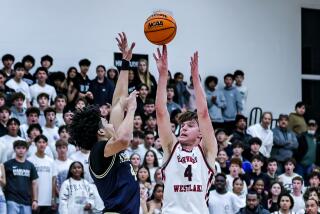High School Basketball Draws Line, Adopts 3-Point Rule
- Share via
When Butch Hawking heard the news Thursday from his father, Bob, the Simi Valley High basketball coach, his eyes grew as big as saucers. Six-foot guards like himself may stand a bit taller in high school basketball next season.
The basketball rules committee of the National Federation of High School Athletic Assns. has voted to put the 3-point rule in effect for the 1987-88 season. Shots made beyond the 19-foot, 9-inch line, the same distance as in college basketball, will count for three points next season.
The Southern Section, which used the rule on a trial basis last season, and the City Section probably will adopt the rule unless the state appeals the decision, which is unlikely according to a City Section official.
“I’d be surprised if the state contradicts it,” said Hal Harkness, director of interscholastic athletics in the City Section. “I’m assuming we’re going to have it.”
That comes as good news to Butch Hawking and many Valley-area coaches who support the rule, saying it will make the game more exciting.
“This makes the little man more important,” North Hollywood Coach Steve Miller said. “You don’t need a big man to win. A guard can almost dominate a game now.”
Hawking, a junior guard on Simi Valley’s 26-2 team, may not dominate next season, but he likely will be more productive.
“I averaged 10 points and after watching the films, I think I would have averaged 15 if we had the rule this season,” Hawking said. “The rule will make the game more exciting and will open up the inside game.”
Hawking can’t wait to start practicing the shot. “As soon as they put the line down, I’ll be living in the gym,” he said.
Peter Nappi, a North Hollywood senior guard, averaged 14 points and he could have averaged 20 with the 3-point rule, Miller said. Perhaps the biggest benefactor of the rule would have been Taft’s Kevin Franklin, who led all Valley scorers with a 31.6 average.
“My first reaction is, ‘Why not last year?” Taft Coach Jim Woodard said. “Kevin would have had more of those than anybody. What timing.”
Despite enthusiasm for the rule, many coaches believe its impact will be minor next season.
Said Woodard: “A lot of kids shoot from 15 to 17 feet well, but add two feet and it’s a different story. It’s still a good distance for high school, but it won’t have a huge impact.”
Birmingham Coach Jeff Halpern, whose team won the Northwest Valley League title and finished with a 22-3 record, echoed Woodard’s sentiments, saying, “I didn’t see many players who can shoot consistently from that range, so I don’t see it having a dramatic effect. Except maybe for the end of the game, it won’t be a part of my offense.”
But it will affect defenses, Halpern said. “Somebody has to prove he can shoot from out there, but once they do you’re going to have to go out and play honest defense. You can’t sit back in a zone,” he said.
Miller, who said he grew to like the rule by watching college games this season, plans to change his strategy next season.
“If we get a three-on-two fast break, we’re going to have one of the wings stop behind the 3-point line to take that shot instead of the layup or 10-foot bank shot. In summer league, we’re going to put the tape on the floor and see who can shoot from there,” he said.
Miller’s only objection to the rule is the control he loses as a coach.
“I’m not sure I like it in the last three or four minutes of the game,” he said. “You can have a team beaten and they can come back and beat you with bombs. I feel I have less control as coach.”
Another objection may come from officials, who are two to a team in high school instead of the three in NCAA Division I play.
“In college, it’s a three-official function,” Harkness said. “The rule puts a great deal of pressure on two officials, especially when the shot comes from the side. The official is concerned with where the shooter’s feet are and may miss a foul.”
Don’t expect the City to adopt a third official. “The cost of a third official is prohibitive,” Harkness said. “That alternative is unacceptable.”
More to Read
Get our high school sports newsletter
Prep Rally is devoted to the SoCal high school sports experience, bringing you scores, stories and a behind-the-scenes look at what makes prep sports so popular.
You may occasionally receive promotional content from the Los Angeles Times.






